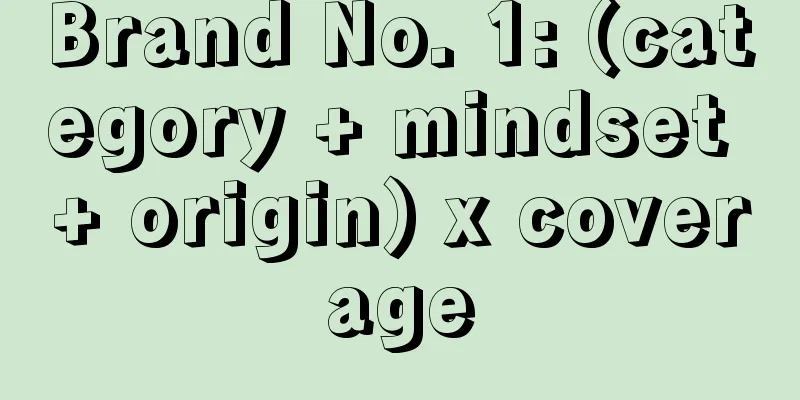Brand No. 1: (category + mindset + origin) x coverage

1. Category is the foundationCategory is the foundation: Thinking from the perspective of category is the first step in business. Category is the mother, the overall market and the foundation of business. Only a rich category matrix can give birth to a strong brand vitality. So, what is the category behind the product? It is said that it is good to lean on a big tree for shade and that a pig standing in the wind will fly. Big trees and vents are actually the bonuses that come with the category. Business is constantly differentiating, and differentiation brings opportunities - opportunities to create new categories. Those who are one step ahead are martyrs, and those who are half a step ahead are role models. How to judge whether you have taken a step or half a step is actually a reflection on differentiation and new categories. Discovering and selecting category opportunities is the primary business decision for entrepreneurs. Category differentiation brings new market space, and differentiation is the driving force of business development. It is obviously unwise to start a war in a fiercely competitive price range and it requires more resources. New media generates new content, new content brings new people, and new people trigger new brand opportunities. Many products don’t sell well not because they are bad, but because they are too good. So good that companies put their products in front of consumers before consumers have any idea of the category, the value of the category, or even the name of the category. This approach is not innovation, but adventure, or even a challenge—a challenge to consumers’ cognition. It is important to distinguish what are trends and what are popular. Not all ships can take you to discover new business worlds. Many times, this ship may be the Titanic, which is going to take you to death. How to judge whether a new category is a trend or a fad: We use the simplest criterion, which is based on the underlying judgment - the secrets of business are in the colloquial expressions of customers. Because consumers think in categories and express themselves in brands. At this time, we need to see, research and observe how consumers express their needs. 2. Competition depends on mentalityCompetition depends on the mind: what is on the market is not important, what is in the cognition is important. Competition on shelves is always a red ocean, but if you look at it from the perspective of consumer perception, you will find a blue ocean. That is, products with categories but no brands. This involves three dimensions: category, product, and brand. The essence of differentiated competition is to form differentiated cognition on the consumer side, guide facts through cognition, and strengthen cognition with the help of facts. On the one hand, it is the factual differentiation support at the product level, and on the other hand, it is the differentiated cognitive segmentation of consumers. Milk brands include Mengniu, Yili, and Bright Room temperature yogurt includes Amul, Pure, and Mosilian However, there is no number one brand in the cheese category in the minds of consumers. What you can see, your opponent can see as well, and your opponent must want to win as much as you do. This is indeed the case. In 2020, more than 150 new registered companies whose business scope or products include "cheese" were added. In the past 2021, there were more than 49 cheese stick brands on the market, which was very lively for a while. Cheese newcomer: Miaofei, founded in 2018, successfully won two rounds of financing in 2020 after its products were launched in 2019. Its founder Chen Yun has served as general manager of Yili Cheese Division and vice president of Meike Landou. Dr. Cheese, founded in 2019, completed equity financing in 2020 and 2021, including well-known investment institutions such as Challenger Capital and Sequoia China Seed Fund. Old brands are coming: Junlebao Group held a new product launch conference in Tianjin, officially launching the cheese sticks with the recipe of Zeng Cheese La Zengcong and the newly upgraded Sikeqi cheese sticks. Sanyuan, the 2020-2021 Sanyuan Cheese Development Sharing Conference, also officially included the cheese business into the company's "strategic level" project, and specially established the Cheese Academy of the Special Channel Division. Facing the attack from new and old competitors, the problem is not how to defeat the competitors, but how to quickly create the cognitive advantage of the Meiji Landou brand. Meiji Landou knows that competition only takes place in the consumer's cognition, and the method to seize the cognitive vacancy is to launch a saturation attack in the blank mind by "sea, land and air". Two Tigers and Meiji Landou have been launched by land, sea and air to capture the minds of consumers: relying on the elevator advertising bombardment of Focus Media and the brainwashing advertising songs of Two Tigers and Meiji Landou, Meiji Landou has captured the minds of consumers. When we first launched the Focus Media, we thought that the four words "Miacole" were difficult to remember, so how could we make them memorable? We decided to use songs to spread the word and make people remember Miacole. We found the French nursery rhyme "Two Tigers" and adapted it into "Miacole, Miacole, cheese sticks, cheese sticks..." It is very familiar to everyone - Chai Xiu, Chairman of Miacole. 3. Three Origins of the MarketThe origin market, the origin crowd, and the origin channel are a process of mutual emergence. Through the origin crowd, the origin channel can be clearly identified, and then the origin market can be found in the process of continuous superposition of the origin crowd and the origin channel. Sometimes the market is a general concept. To be precise, market = channel + crowd. In the process of 0 to 1, the first thing to understand about the market is the origin crowd. That is, to have a clear portrait of the origin crowd. The so-called origin crowd portrait is not just about age, gender, income, and education, but more about the behavior, preferences, and catalyst habits of the origin crowd. For example: the preferences of the origin group for media and content, whether it is Xiaohongshu, Douyin, pictures and texts, or short videos; in addition, attention should be paid to the "portraits" with opinion leader characteristics among the origin group, who usually become super users, which requires "tracking" of the data and behavior of the origin group. For example, you can focus on following up on 10 original customers, their Weibo, Douyin, and Xiaohongshu historical pictures and texts. You can create a group and send small benefits and surprises regularly. Then, gradually clarify the original group's understanding of the functions and benefits of the product. In other words, the significance of the original group is to understand how real consumers buy (demand, cognition), understand why real consumers buy (value, selling points), understand where real consumers buy (channels, media), and understand how real consumers use it (scenario, repeat purchase). By understanding the real consumers, we can gradually understand how consumers buy, why they buy, where they buy, and how they use them, and then gradually improve and establish a clear initial market cognition. Once this initial cognition is established, the subsequent source channels will gradually become clear. Even vice versa, the product publicity, media, promotion, pictures and texts, and KOL placement will also be targeted. The logic of people, goods, and places is to go from the origin crowd (people) to the origin channel (place), and then achieve the matching of people, goods, and places, and find the origin market. Then establish and build a model market, and gradually establish a base. From 4P to three origins, then to model market, and then to base construction. 1. Origin market = Origin crowd + Origin channelThe origin market is not an independent concept, but a product of the continuous superposition of origin people and origin channels. That is, through the origin crowd, the origin channel is clarified; through the origin channel, the origin crowd is enlarged. As the origin crowd and the origin channel are continuously superimposed, the origin market gradually becomes clear. After the origin market is clear, we select the most exemplary market based on sales data and users as the strategic target market. The significance of the strategic target market is that it can be grown, quantified, and replicated, and it can prepare data, strategies, and models for entering the mainstream market later. In addition, when there is no clear portrait of the origin group, premature brand emotional publicity will attract non-origin groups. At this time, it is often difficult to sustain after a wave of sales. We still have to go back to the origin group and find the brand's tone through the portrait of the origin group. Brand tone is not the personal preference of the brand manager, but the discovery, excavation and sublimation of the emotions and feelings of the origin group. 4. Covering the third level of grass plantingCoverage possibility: Through what channels, media, advertising, and public relations can potential customers be reached. This is a question of the communication scope after the consumer's self-portrait. When we talk about precise coverage, it is also precision under the premise of quantity. Without quantity, there is no quality. If you want quality, you must first ensure quantity. This sentence is the same for coverage. 1. Product recommendationConsumers recognize brands through products, and complete their initial recognition of brands through product functions, services, and usage experience. Therefore, in this stage (new consumer brands 0 to 1), the seeding should focus on the functions, usage, and experience of the products. Let consumers know clearly what your products are, why they choose you, and why they trust you; that is, clarify the category, clarify the differentiation, and establish credibility. The selection of KOLs, on the one hand, builds trust and makes them credible, and on the other hand, reaches potential consumers. The logic of selecting KOLs is the logic of brands sending signals to potential consumers. The signal source must be strong, the signal coverage must be large, and the signal must not be interrupted. The signal source must be strong: The KOL itself must have strong influence. A KOL with 1 million followers is different from a KOL with 100,000 followers; a vertical KOL is different from a non-vertical KOL. When choosing, you should first choose vertical and then general. The more vertical the information source, the stronger it is. Signal coverage should be large: Coverage is a measure of magnitude, and large coverage means trying to increase the magnitude as much as possible. This magnitude is best to be a phased magnitude under the same keyword. The signal cannot be interrupted: the essence of long-termism is not to cross the big cycle, but to continuously penetrate the small cycle; it is an ability and action to cross the small cycle and see through the big cycle. Each small "peak" represents the new consumer brand that continuously transmits signals to consumers, traversing from products, brands, competing products, categories, cross-categories, and scenarios, and finally establishes a unique brand mindset. For example, the mature brand Feihe milk powder has long been conveying a core concept that it is more suitable for the physique of Chinese babies. Of course, this statement does not stand up to thought. Does it mean that foreign milk powder is not suitable for the physique of Chinese babies? Obviously, this is not the case. However, cognition is greater than facts, and signals cannot be interrupted. Repetition can establish cognition and then influence cognition. 2. Breaking the circle and planting grassAfter the product planting stage, we enter the stage of breaking the circle planting. The so-called breaking the circle planting is based on the brand user portrait in the first stage, gradually penetrating into competitors, category users, and then penetrating into cross-category and scenario users. Focusing on the A2-A3 population, complete the user population portrait, based on the A2-A3 user population portrait, iterate keywords and penetrate the population. For example: After April 2019, the scenarios for Xiaoxiandun's advertising began to change. The proportion of "weight loss" scenarios decreased to 11%, and the proportion of "skin care" scenarios was the highest, accounting for more than 45% of the total ratio. The proportion of "pregnancy care" and "freezing age" scenarios increased significantly, and the proportion of "health preservation" scenarios was still at the bottom. We used super-head KOLs to increase awareness, and used "weight loss", "skin care", "anti-aging", "health preservation", and "pregnancy care" as keywords for penetration. We gradually developed the core keywords: skin care as the main focus, health preservation as the foundation, pregnancy care, and anti-aging as the grass-planting strategy to penetrate the population. 3. Mental seedingThe core logic of a brand lies in the logic of the market. A brand is a tool for an enterprise and a way to occupy the minds of consumers. The core of branding is to make the brand = category and to let the brand represent characteristics. The form of planting grass must be consistent with the purpose of the brand. We plant grass, but it must grow into a big tree. Only brands that leave a mark in the minds of consumers can overcome the backlash of traffic. Otherwise, they will continue to be blocked by traffic, the cost of media placement will be pushed up year by year, and the price asked by KOLs will naturally rise. From product selling points to keywords, from keywords to crowd portraits, from crowd portraits to labels, from labels to penetration, from penetration to mind. Only by taking this thrilling leap can the brand complete its path of self-growth. Whether online or offline, the ultimate competition is to achieve occupation in the minds of consumers. To achieve occupation with one word, let the brand replace the category and become the synonym of the new category. To cultivate the mind, we need to enter into the coordinated operation of all media and all channels. Online hits, offline harvesting, Internet celebrities bringing goods, KOL follow-up, and targeted elevator advertising areas to ignite. When consumers are repeatedly exposed to "grass-planting content, live streaming, targeted advertising, and KOL short videos" during distribution and penetration, and identify with the "warmth" conveyed by the brand, the brand will gain a place in the minds of consumers, achieving a word occupation and eventually becoming synonymous with a new category/new track. Author: Houshankeju WeChat Official Account: Laogao Business and Brand |
<<: Li Pen, a poet in the copywriting world
>>: The 9.9 yuan photo album was discontinued after a week, are the hippocampi stable now?
Recommend
In this era, everyone can become a super individual and achieve the growth of assets from 0 to 1 and then to 10
In today's era, everyone can become a super in...
Paying for knowledge is compound interest, but it should not be huge profits!
Knowledge payment has been very popular in recent ...
What does Amazon's exposure click-to-conversion rate mean? Detailed answer
If we open a store online, we need to know what th...
Will Amazon's new store be stable after three months? How long does it take for Amazon's new store to place orders?
For a new store, whether it can achieve stable ope...
Label your brand and break the dilemma of homogeneity!
The pace of the times is accelerating, and brand o...
Using AI to write online articles to make money: underlying illusions and technological destiny
With the rapid development of AI technology, the f...
A Complete Guide to Writing Data Analysis Reports
Writing data analysis reports is the most basic sk...
How does Shopee refund the price difference to customers? What should I do if the customer asks for a refund of the price difference?
After some Shopee customers bought a certain produ...
How much does it cost to open a store on Amazon without supply? How to do it?
When opening a Taobao store, you can choose a supp...
What is the interview process for Shopee Singapore? Will there be a rejection letter during the Shopee interview?
As the headquarters of Shopee, Singapore's int...
To analyze indicator fluctuations, the data model should be built like this
How to analyze indicator fluctuations? The author ...
Is it difficult to pass the temu product selection? How does Temu select products?
Temu, as Pinduoduo's cross-border platform, ha...
Where does Shouxin Easy Pay deduct money? What is Shouxin Easy Pay?
ShouxinEasy is the first third-party payment brand...
An inventory of banned words on 6 major platforms including Xiaohongshu, Douyin, and Video Account
As the saying goes, it is better to be safe than s...
How to calculate the conversion rate of an independent website? What does the conversion rate of an independent website mean?
There are actually quite a lot of merchants who wa...









